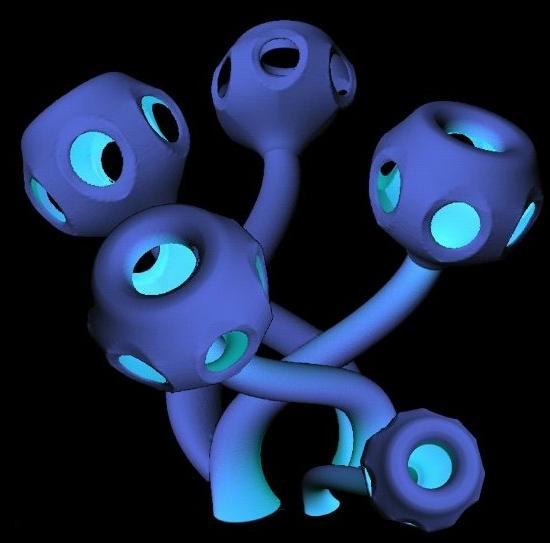 Abstract:
Watters, M.Sc. Thesis, MIT 2000: Siliciclastic successions
of terminal Proterozoic age contain moderately diverse, commonly
problematic fossils of soft-bodied organisms, collectively known
as the Ediacaran biota. Many rocks that host Ediacaran assemblages
also contain a limited diversity of metazoan trace fossils.
In contrast---and in strong contrast to Cambrian and younger
successions---terminal Proterozoic limestones have been thought
to yield only limited evidence of animal life. A major exception
to this pattern is provided by Cloudina , a calcified fossil
known almost exclusively from uppermost Proterozoic carbonate
rocks. Until now it has been unclear whether Cloudina should
be regarded as the exception that proves the rule or as a hint
that more diverse animals inhabited carbonate platforms before
the dawn of the Cambrian.
Abstract:
Watters, M.Sc. Thesis, MIT 2000: Siliciclastic successions
of terminal Proterozoic age contain moderately diverse, commonly
problematic fossils of soft-bodied organisms, collectively known
as the Ediacaran biota. Many rocks that host Ediacaran assemblages
also contain a limited diversity of metazoan trace fossils.
In contrast---and in strong contrast to Cambrian and younger
successions---terminal Proterozoic limestones have been thought
to yield only limited evidence of animal life. A major exception
to this pattern is provided by Cloudina , a calcified fossil
known almost exclusively from uppermost Proterozoic carbonate
rocks. Until now it has been unclear whether Cloudina should
be regarded as the exception that proves the rule or as a hint
that more diverse animals inhabited carbonate platforms before
the dawn of the Cambrian. This thesis presents evidence for a paleoecologically distinctive assemblage of calcified metazoans in thrombolite-stromatolite reefs and associated facies of the terminal Proterozoic Nama Group, Namibia, where Cloudina was originally discovered. Particularly abundant are cm-scale goblet-shaped fossils described in this thesis as Namacalathus hermanastes gen. et sp. nov. and interpreted as lightly mineralized, attached benthos comparable to simple cnidarians in body plan. These fossils are characterized by a slender stem open at both ends, attached to a broadly spheroidal cup marked by a circular opening with a downturned lip and six (or seven) side holes interpreted as diagenetic reflections of underlying biological structure. Namacalathus lived atop the rough topography created by ecologically complex microbial-algal carpets; they appear to have been sessile benthos attached either to the biohermal substrate or to seaweeds that grew on the reef surface. The phylogenetic affinities of Namacalathus are uncertain, although preserved morphology is consistent with a cnidarian-like body plan. In general aspect, these fossils resemble some of the unmineralized taxa found in contemporaneous sandstones and shales, but do not appear to be closely related to the well-skeletonized bilaterian animals that radiated in younger oceans.
The three-dimensional morphology of the reef-associated fossils was reconstructed by computer. Analog methods for reconstructing the morphology of stromatolites and fossil invertebrates are widely used (e.g. Vanyo and Awramik 1982), while digital reconstruction techniques are still uncommon. For one example, Schmidtling (1995) presented a digital reconstruction of the internal morphology of blastoids. The reconstruction techniques described in this study were developed independently of these methods.
The reconstructions in the present study are based upon digital images of sections taken at 25 micron intervals through numerous specimens. This process involves a number of image processing techniques, used for obtaining the contour outlines of fossils in cross-sectional images. The resulting "tomographic" models are then used to construct a mathematical description of the morphology, which is specified using a pair of two-dimensional vector-valued functions of a vertical position parameter. Several characters that are observed to vary between individual tomographic specimens are assigned parameters in the mathematical model. In this way it is possible to construct "idealizations" of individual tomographic reconstructions. Two mathematical models are used to generate a database of synthetic cross sections that is nearly comprehensive. This database contains the vast majority of cross sections observed in outcrop, and can be used to identify assemblages of Namacalathus in the field. Moreover, this database is used to identify Namacalathus specimens in the stacks of cross-sectional images, in order to collect statistics about the percentage of fossils by type, and also regarding the orientation, size, and shape of Namacalathus specimens from a single rock sample.

